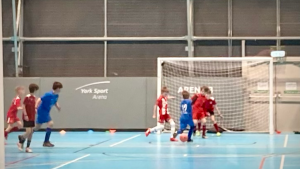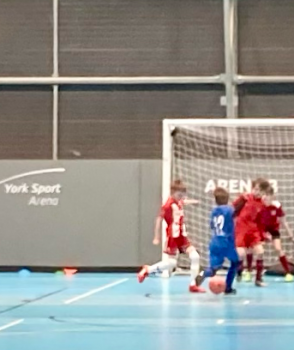From starting football coaching I was aware of the high regard futsal was held in as a way to develop young players skills and decision-making. The fact that Pete Sturgess, a futsal coach, was head of the foundation phase at the FA undoubtedly helped. But when my youngest son started playing futsal for himself it opened my eyes to the many benefits that learning to play futsal well can transfer to his grassroots football game.

As a result I’ve started incorporating elements of futsal into my football coaching. Here are the top five benefits of futsal as I see them:
1. Futsal encourages fast decisions
The speed of futsal combined with the tight areas the game forces you to play in encourages lots of decisions.
Unlike in a grassroots game, where a player even at the foundation phase might get a couple of seconds to decide what to do with the ball, futsal players may get just fractions of that time.
In turn this demands an awareness of the complete environment – where are their teammates, where are their opponents, how fast are they travelling in which direction, where is the space, where will it be in the immediate future, where is the goal.
And then of course once one decision has been made – say, to touch the ball from one foot to the other then lay it off to a teammate – you have to make another one equally quickly.
And it’s not just the speed of decisions that futsal brings – it’s the volume. Players have to make decision after decision after decision after decision, at a far greater rate and depth than in a football game.
But the mental skills this develops will transfer across to – and are invaluable in – grassroots football.
2. It uses a heavier ball
The use of heavier balls in futsal is one of my favourite things about the game. It encourages dribbling, small touches and short passes along the ground rather than kicking it long or going via the aerial route.
Kids have to play their way out of trouble – the classic advice to “get rid” isn’t so easy to put into practice with a futsal ball – and that, in turn, develops their touch, vision, confidence and skill at managing risks.
At the elite level it is easy to spot players from the countries where kids play more futsal growing up. Spanish, Portuguese and Brazilian players – and perhaps to a lesser extent Italian, Russian, Uruguayan and Argentinian players – seem so much more at ease in possession as a general rule that the link is clear.
This is the biggest part of futsal that I incorporate in my grassroots coaching. My club’s winter training is by necessity carried out on an old-style astroturf pitch. Normal footballs skid off the surface making control unnecessarily difficult, and can be pinged around the pitch with the lightest of touches. It’s nothing like playing on grass.
And while it never will be, using a heavier futsal ball at least asks players to use the same weight of force when dribbling or passing in training that they need in matches.
Plus, using a futsal ball discourages them from shooting from anywhere in training – an extra bonus!
3. Futsal is naturally a small-sided game
Okay, so practising in small-sided games isn’t exactly something that futsal has uniquely brought to the world. I didn’t have to watch a futsal world cup final to work out that playing 4v4 has lots of benefits that 7v7 or 9v9 doesn’t. But let’s capture them here anyway.
Small-sided games mean more touches for players. It’s obvious that in an 8v8 game only one player can be in possession of the ball and the other 15 are playing without it. If you split that match into two then straight away two players can be on the ball at any one time in your training session. If you break it up into two 3v3s and a 2v2 then three players can be on the ball and so on. And that means that lots of players who in an 8v8 wouldn’t see much of the ball at all – those that tend to be smaller, quieter or less confident at going into challenges – will get much more meaningful practice in smaller sided games.
Furthermore, small-sided games almost by definition come with more transitions – or at least more meaningful transitions. Watch a futsal match at almost any level and you’ll see that it’s one transition after another – it’s impossible for a futsal team to keep the ball in the same way that an 11-a-side team can. Players are constantly challenged to switch between in-possession and out-of-possession mindsets, and that kind of intense mental workout will inevitably improve their skills and tactical thinking in transitions in football too.
4. It uses a small playing area
Again, playing in a small area isn’t something that only futsal can deliver insights on, but if your players play futsal they will reap the benefits it provides.
Certainly futsal is more challenging than traditional British indoor or 5-a-side football, where usually players can bounce the ball off the walls and not worry about it going out of play.
Futsal demands that players have to work hard and use strength and technique to keep the ball on the pitch – just like in the game of football.
Other than that, futsal delivers the same benefit as any football game played in a small area – possession skills become paramount and the game forces players to make fast decisions to solve the problems that the tight playing area and corresponding close pressure from opponents gives them.
There are also fitness benefits. Futsal demands short, intense sprints, with constant changes in direction and pace. The use of rolling subs means that there’s no need to rest in the game – it’s just one intense workout for as long as you’re on the pitch.
5. It promotes fluid positioning and tactical flexibility
Possibly my favourite aspect of futsal as a game is the fact that it demands universality. Anyone who sends their child onto a futsal pitch with the idea that they are “a striker”, “a winger”, “a stopper”, “a number 8”, will soon be disabused of that notion.
As a relative newcomer to futsal I find it amazing that at the speed top-class players play there are any tactics at all. If I was to play myself I suspect I would start with vague tactical ideas from football in my head, which would quickly turn into me running round like a headless chicken. But top-level futsal even in the UK is actually very tactically sophisticated.
Nearly all ways of playing, though, are based on an assumption that when our team is in possession of the ball we are all attackers. And when the other team has the ball we are all defenders.
From that there then comes an idea that we need to determine our position on the pitch based on the position of the ball and the other players – the exact determination depending on agreed strategies and tactics. It’s like a small-sided version of Pep Guardiola’s juego de posición. And who wouldn’t want their footballers to learn how to play like that?
In summary, I would encourage any grassroots coach to incorporate elements of futsal into their football coaching – from U5s through to open age. It delivers technical, tactical and physical benefits to a greater depth than much traditional grassroots coaching.
To find out more about futsal coaching, try Pete Sturgess’s Futsal: Training, Technique and Tactics. To learn more about futsal and its culture in the UK and around the world, I recommend Jamie Fahey’s Futsal: The Story of An Indoor Football Revolution.

